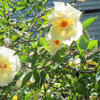This May Be My Last Year For Roses
ingrid_vc so. CA zone 9
9 years ago
Featured Answer
Sort by:Oldest
Comments (67)
muscovyduckling
9 years agolast modified: 9 years agoingrid_vc so. CA zone 9
9 years agolast modified: 9 years agoRelated Discussions
Last year my elephant ear bulb rotted. Advice needed this year.
Comments (4)Thanks so much Debbie for replying to my post. I think I see what I did wrong last year---I continued to water as usual because I knew that the elephant ears liked moisture. I did not reduce the water to trigger dormancy as you suggested. Our average frost date is mid October. I have noticed that the nights are cooler than before and the day temperatures are lower too. I think it will be time soon to stop watering. I will cut the top off and check on the bulb. I wouldn't want to bring it in with its pot (too big) and then find out it had rotted! My other elephant ears are smaller. I think I will pick one of them to keep as a houseplant. The only worry I have (besides bulb rot) is fungus gnats since the soil likes to be kept moist. The other three elephant ears I'll keep in their pots, but stop watering until spring. I sure hope this all works out! Thanks so much! By the way, Illustris is a lovely elephant ear. . . don't you think?...See MoreWill my amaryllis bloom this year after not blooming last year?
Comments (20)Last year, my bulbs were in lawless conditions. I bought a children pool and put them in it in their pots. It was easier to water them this way. I just poured the water in and they all got some. But then some rains came and completely drenched the bulbs. They were neck up to the water and they stayed that way for a long time by the time I noticed it and let the water away. So I ended up with most of the bulbs shrunk to tiny bulblets that I didn't think would even survive. Then I had to move to the new house, so I unpotted them, cut the leaves and put them in the new wine cooler I bought for this purpose to make sure that the bulbs do not freeze down. A month later I noticed that the wine cooler froze down and even killed about 10 bulbs. I returned it to the store and just bought a huge standing fridge that had the freezer part separately. I kept my bulbs in that fridge. Then I planted them up from Summer, hoping that they would still come back to me. And to my amazement: More than 50 percent FLOWERED! They shrunk, they were sitting in water, they froze down, they were in dormancy for a half a year or LONGER, and they BLOOMED! I am still floored by some of them. Now, they are out in the flower bed, fattening up. I hope they enjoy the situation. So you see, once they want to bloom, they just bloom, even if they kill themselves....See MoreA few of my last roses of the year
Comments (7)Very pretty roses, Jen. I also think the Parade mini is an unusal stripe and I like the pure apricot one also. Very complementary pair to grow together...I have a couple apricot/orange ones out in my garden that haven't bloomed yet and when they do, I'll remember yours and see if they look they yours. Sure makes the fall mornings cheerful to have some pretty roses in a vase though. Thanks for sharing. Leslie...See MoreWill my knockout rose plant that i bought last year revive?
Comments (11)That's the attitude. It's hard, but not impossible to overwinter them. Was this unheated garage attached to your house? If not, it's unlikely to ever work in your zone. As suggested, raise them off the floor and use a bigger pot which will give the roots more insulation as well. You could also wrap the pot in bubble wrap or something insulative. That, plus water will give them a fighting chance. I've done this for a few years now, but will admit to some losses this year, but only because I didn't realize outside air was entering the space due to some structural changes. I'll be fixing that. Any chance you can put a rose in the ground?...See Moresummersrhythm_z6a
9 years agolast modified: 9 years agoKippy
9 years agolast modified: 9 years agoingrid_vc so. CA zone 9
9 years agolast modified: 9 years agojaspermplants
9 years agolast modified: 9 years agoannesfbay
9 years agolast modified: 9 years agogothiclibrarian
9 years agolast modified: 9 years agohoovb zone 9 sunset 23
9 years agolast modified: 9 years agosummersrhythm_z6a
9 years agolast modified: 9 years agojaspermplants
9 years agolast modified: 9 years agoKippy
9 years agolast modified: 9 years agoalameda/zone 8/East Texas
9 years agolast modified: 9 years agojaspermplants
9 years agolast modified: 9 years agoKippy
9 years agolast modified: 9 years agoUser
9 years agolast modified: 9 years agoKippy
9 years agolast modified: 9 years agoKippy
9 years agolast modified: 9 years agodavidrt28 (zone 7)
9 years agolast modified: 9 years agodavidrt28 (zone 7)
9 years agolast modified: 9 years agoportlandmysteryrose
9 years agolast modified: 9 years agofogrose
9 years agolast modified: 9 years agoingrid_vc so. CA zone 9
9 years agolast modified: 9 years agoUser
9 years agolast modified: 9 years agoArbutusOmnedo 10/24
9 years agolast modified: 9 years agoSow_what? Southern California Inland
9 years agolast modified: 9 years agoLynn-in-TX-Z8b- Austin Area/Hill Country
9 years agolast modified: 9 years agoseil zone 6b MI
9 years agolast modified: 9 years agoUser
9 years agolast modified: 9 years agominflick
9 years agolast modified: 9 years agoroselee z8b S.W. Texas
9 years agolast modified: 9 years agoingrid_vc so. CA zone 9
9 years agolast modified: 9 years agorosefolly
9 years agolast modified: 9 years agorosefolly
9 years agolast modified: 9 years agonancylee2
9 years agolast modified: 9 years agoUser
9 years agolast modified: 9 years agoingrid_vc so. CA zone 9
9 years agolast modified: 9 years agoLynn-in-TX-Z8b- Austin Area/Hill Country
9 years agolast modified: 9 years agonippstress - zone 5 Nebraska
9 years agolast modified: 9 years agoluxrosa
9 years agolast modified: 9 years agokittymoonbeam
9 years agolast modified: 9 years agoKippy
9 years agolast modified: 9 years agoLynn-in-TX-Z8b- Austin Area/Hill Country
9 years agolast modified: 9 years agoingrid_vc so. CA zone 9
9 years agolast modified: 9 years agonikthegreek
9 years agolast modified: 9 years agoUser
9 years agolast modified: 9 years agoingrid_vc so. CA zone 9
9 years agolast modified: 9 years agoUser
9 years agolast modified: 9 years agoingrid_vc so. CA zone 9
9 years agolast modified: 9 years agoUser
9 years agolast modified: 9 years ago
Related Stories

HOLIDAYSA Thanksgiving Tradition to Last the Whole Year
Looking for a thoughtful yet simple way to capture your family's gratitude? Grab a jar and paper
Full Story
WINTER GARDENINGPruning Secrets for Exquisite Roses
Encourage gorgeous blooms year after year with this time-tested advice on how to prune your rosebush in winter for health and shape
Full Story
COLORColors of the Year: Look Back and Ahead for New Color Inspiration
See which color trends from 2014 are sticking, which ones struck out and which colors we’ll be watching for next year
Full Story
DECLUTTERINGYour Clutter-Clearing Plan for the New Year
Tackle these tasks month by month for a decluttering strategy that will really pay off
Full Story
COLORHow to Use Marsala, Pantone’s 2015 Color of the Year
Pantone digs deep and goes earthy with its selection. Here are ways to make it work in your home
Full Story
HOLIDAYSSimple Pleasures: Welcoming the New Year
Got the champagne and party hats but stumped about what to do next? Try these festive entertaining ideas to ring in the new year
Full Story
MOST POPULAR8 Life-Enhancing Home Resolutions for the New Year
You can take steps to make this the year your home truly becomes a place of comfort and joy
Full Story
FALL GARDENINGReflecting on a Gardening Year
Mistakes and successes, surprises and comforts. The garden helps us grow in new ways every year
Full Story
DECLUTTERINGClutter vs. Keepers: A Guide to New Year's Purging
Simple questions to get in touch with your clutter comfort level — and figure out what needs to go
Full Story
DECORATING GUIDESTangerine Tango: 4 Ways to Use Pantone's Color of the Year
Don't let this bold hue scare you — try warming up any room with this cheerful red-orange color of 2012
Full Story








toolbelt68